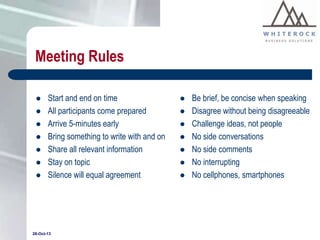Running effective meetings presentation
- 1. Running Effective Meetings “If you had to identify, in one word, the reason why the human race has not achieved, and never will achieve, its full potential, that word would be meetings.” – Dave Barry
- 2. Facts about meetings Statistics show … 37% - Of employee time is spent in meetings 60 – Number of meetings per month attended by business professionals 11 Million – Number of business meetings every day in the U.S. 31 hours – Number of hours spent in unproductive meetings each month 73% – Of professionals admit to doing unrelated work in meetings 39% - Of professionals admitted dozing off in meetings 63% - Of meetings do not have prepared agendas 49% - Of meeting participants considered unfocused meetings as the biggest workplace time waster 28-Oct-13
- 3. To meet or not too meet, that is the question What are the objectives? – – – – – 28-Oct-13 What’s the purpose of the meeting? What do we hope to accomplish? What information will be shared? What decisions will be made? Who would be attending? Is there a better or more efficient way to satisfy the above objectives?
- 4. Reasons for meetings 28-Oct-13 Provide information Solicit information Answer questions Group decision making Brainstorming ideas Problem resolution Networking Sell ideas, products, services
- 5. Meeting Facilitation Facilitation – n. making easy, the act of assisting or making easier the progress or improvement of something Facilitators – – – – – 28-Oct-13 Manage the agenda Ensure objectives are met Ensure participation Ensure meeting was worthwhile Ensure follow up on action items
- 6. What makes a good facilitator? 28-Oct-13 Open minded, not too emotionally connected High energy and attention to detail Good understanding of the meeting tasks and long term goals of the team Good listening skills Good insight into attendees personalities, motivation High degree of confidence Assertive, but not aggressive Good team work skills Good observation skills
- 7. Facilitator Responsibilities 28-Oct-13 Prepare a meeting agenda and send out prior to the meeting Provide all necessary handouts Start on time Listen carefully Prevent digressing Control conflict and hostility Go through the agenda item by item Seek contribution from all attendees Monitor nonverbal communication Seek clarification and elaboration Conclude by summarizing meeting accomplishments and “to do” items Send out meeting summary within one day of meeting
- 8. Meeting Rules Start and end on time All participants come prepared Arrive 5-minutes early Bring something to write with and on Share all relevant information Stay on topic Silence will equal agreement 28-Oct-13 Be brief, be concise when speaking Disagree without being disagreeable Challenge ideas, not people No side conversations No side comments No interrupting No cellphones, smartphones
- 9. What makes a good agenda? Specify date, place, starting and ending time Provide statement of the purpose of the meeting Identify the attendees List the topics to be covered in the sequence they will be covered Identify approximate time to be spent on each topic Identify/provide pre-meeting reading/assignments Distribute agenda at least one week prior to the meeting Follow up two days before the meeting to ensure attendance and assignment completion 28-Oct-13
- 10. How to stop tardiness Schedule meetings at odd times Start on time Close the door when the meeting starts Put the most important agenda items first Put items applicable to chronic latecomers on the top of the agenda Solicit help from other attendees Speak privately to chronic latecomers 28-Oct-13
- 11. Keeping meetings lively Hold morning meetings Serve light lunches or snacks if meetings run into afternoons Keep rooms cool and bright Facilitate more than dominate Ask questions of quiet attendees Give attendees responsibilities for parts of the meeting Arrange seating for maximum eye contact 28-Oct-13
- 12. Facilitator Tools 28-Oct-13 Brainstorming Go-rounds Talking stick Silent Generation Nominal Group Technique Brain writing Pool
- 13. What about your staff meetings? Do attendees freely voice their opinions? Are all ideas thoroughly reviewed prior to acceptance or rejection? Are you making the best use of this meeting time? Are differences of opinion resolved productively? Do all attendees attentively listen and build on other’s ideas? Is there a true climate of trust apparent? Does everyone offer input when important items are discussed? Do attendees leave with clear direction on next steps? Do you periodically solicit input on whether attendees agree with how the meetings are being run? 28-Oct-13
- 14. Summary 28-Oct-13 Make sure you really need to meet. Pick a good facilitator. Establish meeting rules and enforce them. Create an agenda and follow it. Address meeting problems (i.e. tardiness, rule enforcement. Utilize facilitator tools for idea generation. Review and improve meetings.
- 15. Questions? Before I refuse to take your questions, I have an opening statement. – Ronald Reagan 28-Oct-13
- 16. Specializing in Infrastructure/Operations Assessment & Improvement Infrastructure Management Business Process Management Website Assessment & Improvement Five Point Business Health Checkup Project Management You concentrate on running your business, we’ll concentrate on keeping your business running. 28-Oct-13 www.whiterockbusiness.net















